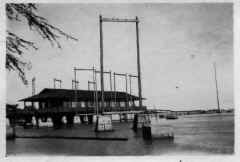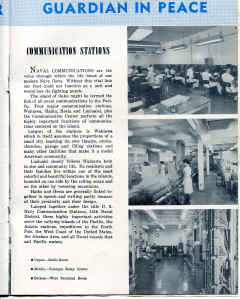Naval Radio Station Wailupe -1921
photos by Harold B. "Skinny" Phelps - Brian Phelps writes - "My Grandfather was a wireless operator on Wailupe during 1921. His name was Harold Bartle Phelps Sr. His Navy buddies called him “Skinny”. After Hawaii, he served in Samoa, Bremerton, WA, and other places. He was recalled to active duty during World War II where he served as a wireless operator again, this time in Alaska on Woody Island among other places."
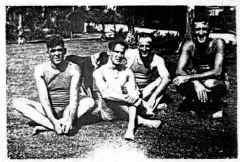
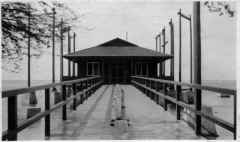
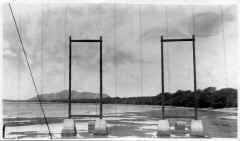
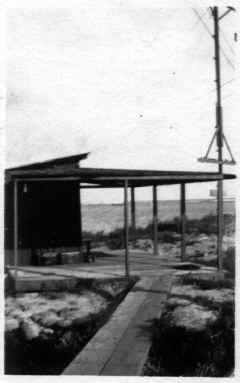
Naval Radio Station Wailupe - 1920's
Naval Radio Station Wailupe -January 1937
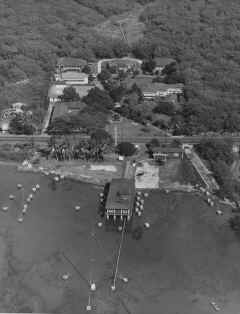
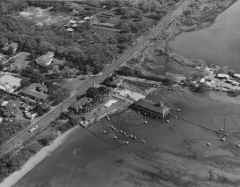
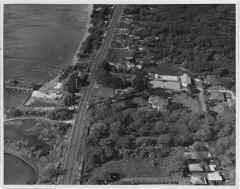
"When we entered World War I, the Navy simply moved a recruiting crew to the commercial station and signed up the entire crew in various ratings in the Naval Reserve, put uniforms on them, and continued to utilize their communication skills under Navy supervision.
The temporary station at Wailupe was probably built around the first part of 1919 and NPM moved there to allow the Kahuku and Koko Head stations to be remodeled. Almost the entire crew of operators at Koko Head was sent to Wailupe as USNR, supplemented by such regular Navy radiomen available. In those days not too many Navy operators had experience in handling commercial traffic.
The Navy purchased a piece of land at Wailupe for the temporary station and it was very temporary as plans were in the making for a permanent station at Wailupe. There were three booths, more like chicken coops, scattered on the beach. Each booth. of crude construction, had room for two circuits. The roofs leaked and some of the operators had to sit under an umbrella suspended from the ceiling to keep water off the equipment. Or we would search around the yard for a scrap of tarpaper or some boards to lead the water off the operating position. There were no signals piped in. Receiving antennas were strung between trees and poles. All control wires were very haywire, no soldered connections and very few even taped, which brought on intermittent wire trouble, rain or shine.
There was an old house on the land. It was one big room, no doors, windows or screens. This housed the office, file rooms, ship to shore circuit and the land wire to the Honolulu city office (HU) and the office in Pearl Harbor (PH). Anyone working in this house after dusk had to put rubber bands around the bottom of their trousers and have several sticks of mosquito punk under their chair to be able to stay there. If they forgot to bring their punk or couldn't find someone else's cache they would stuff an old rag in a can and light it off. Anything was better than those mosquitoes.
We stood a three section watch, seven days a week, no rotation of watches, no days off. Straight 8 on and 16 off, and that's the way it was at the start of NPM at Wailupe as a Government and commercial traffic station.
When I went there in August of 1919, NPM had schedules with NPL (San Diego), NPU (Tutuila, Samoa), NPN (Guam), and NPO (Cavite). There was no direct daylight communication with NPO or JJC (Japan). NPO broadcast to NPM at midnight. NPU broadcast to NPM at 2 a.m. and NPM broadcast to NPU at 9 a.m. None of those circuits were reliable at all times due to static and fading periods. We just kept the traffic moving as best we could, all by hand, on low frequencies. Practically all traffic for Cavite and the Asiatic Fleet was relayed through NPN.
The Navy had been searching around for a piece of land for the permanent station and finally had found some school land that was suitable, for which they traded the temporary site, and started construction of the permanent. buildings. The new site also gave room for expansion up the hill in back of the reservation. The station was completed early in 1921. It was built over the water to provide more land space for the proposed DCOs quarters, two duplex CPO quarters, and the single men's barracks. These were completed late in '21 or early in 1922."
1923 - From LT George Todd, USN RET:
"In the fall of 1923, I was transferred to the Naval Radio Receiving and Control
Station at Wailupe.. There was a shortage of high speed operators at that time.
The permanent buildings at Wailupe had been completed only two years earlier. As
described by Mr. Phelps, the operating building was located over water on the shore of
the bay. (Waialae Bay extends from Diamond Head to Koko Head ) . It. was a rectangular,
one story building on pilings in the water.
The building was divided into compartments or booths, seven on each side separated by a hallway extending the full length of the
building. The front of the building contained the wireroom and the Traffic Chief's
booth on the left; the office of the District Communication Officer, Lt. Comdr. Frank
Loftin, and the office of the Chief Radioman in Charge, D. A. Chauncey, on the right.
The wireroom had Morse code landline circuits to the Old Naval Station in Honolulu
(HU) for transmission of commercial, other government department traffic, and press
news dispatches for the Honolulu newspapers; and a circuit to the Communication Office
in the Pearl Harbor Navy Yard (AD). All message traffic was processed through the
Traffic Chief's booth for circuit routing and filing.
Despite improvement in equipment, reception was still difficult at times due to
static, and fading signals. Separate booths were provided for operators on each circuit
to minimize the additional distractions from outside noises. Prior to and during WWI, receiving equipment had been vastly improved. The Navy
had designed the Models A, B and C receivers and later the SE-143, SE-1120, SE-1530,
SE-1899 and others, and separate units such as the acceptor-rejector and the
ultra-audion. I found all of these types in use at Wailupe. The Baldwin type headphones were
standard, with their hard bakelite earpieces which could be adjusted to the ear by
sliding the earpiece up and down on metal rods attached to the canvas covered headpiece."
1934 - From LT George Todd, USN RET:
"I reported to Wailupe for my second tour of duty in 1934, serving as one of the
Traffic Chiefs until I went back to the Fleet in 1937. The general appearance of the station had not changed much since I left there in
1925. The road JRst the station had been paved. The control station was still in its
original location, however the shore line had been filled in, a breakwater built, the
bridge over the water to the control building had been replaced by a paved walkway up
to the front steps of the building.
One additional set of duplex quarters had been built between the two original
duplexes. A tennis court, swimming pool and recreation building had been constructed
between the single men's barracks and the CPO quarters at the back or the station.
A diversity receiving station had been built on top or the hill behind the quarters.
The inside of the control building was completely changed. All of the former
isolated operating booths had been dismantled, creating one big operating room. RAA,
RAB and RAC receivers were mounted at the sides of the room on individual metal frames,
bolted to the floor. Operating tables were portable, on casters, which could be moved
to any receiver position. Plug in controls were built in to each table and receiver
position.
The Traffic Chief and File Clark occupied back-to-back desks in the center of
the room. A transmitter control panel was mounted alongside the Traffic Chief's desk.
High speed operating positions were located on a long table toward the back of
the room. Typewriter wells and automatic recording devices were situated on both
sides of the table. Kleinschmidt perforators and Boehme keying heads were mounted on
tables against the back wall. A relay rack containing control panels and demodulators
was mounted between the two sets of perforators. Signals from the diversity station
were fed into the control panel. Keying heads and operator positions were also
connected to the control panel. Operators could connect the various equipments in
any combination desired.
The main circuits were with San Francisco and Cavite. Wailupe no longer needed
to relay Cavite traffic through Guam since reliable communications had been established
with Cavite using high frequencies. Guam traffic was routed via Cavite.
The San Francisco and Cavite circuits were usually maintained on a 24 hour high
speed basis using the automatic sending and receiving equipments. Some outages were
experienced daily on the Cavite circuit. At those times messages were pre-punched
for later transmission at high speeds when communications were restored.
Improved signal keyers were provided during my tour of duty at Wailupe. Those keyers
enabled us to feed a signal from the diversity station into a demodulator then to a
control line to the transmitter station to key a transmitter. San Francisco was able
to key the Pearl Harbor transmitter for direct transmission to Cavite. Cavite was able
to duplicate that procedure in the opposite direction. Until those procedures were
perfected by long experience, Wailupe continued to record and transcribe all
transmissions from each station to insure that the distant station did in fact receive the
transmissions.
There was a high frequency circuit, on schedule, with Tutuila, American Samoa (NPU);
another circuit also on schedule with Hilo (NPH); and a ship-shore circuit with Navy
ships on 355 kHz split-foned with 500 kHz, the International Distress frequency.
A FOX method broadcast for Navy ships used the TAW very low frequency transmitter
at Pearl Harbor on 26.1 kHz. The FOX method of broadcasting to ships replaced the former
intercept circuit between San Diego and Wailupe.
The front part of the control building was unchanged from its original format. The
DCO still occupied the front office and the Officer in Charge the next one. The original
wireroom and the Traffic Chief's booth had been converted into equipment maintenance
and battery rooms.
The wireroom had been moved to a room adjoining the operating room. There,
communication was maintained with the Honolulu, Pearl Harbor and Fleet Air communication
offices by teletype - not page printers, but the old Western Union type that fed
gummed tape through the machine which had to be glued to message blanks before delivery
to the Traffic Chief for routing.
Facilities at Wailupe in 1939 were meager, and an entirely new receiving and
control station was under construction. At Wailupe in December 1941 there were
seventy-six men operating twelve positions to receive and send naval dispatches. High speed
Boehme was employed on a continuous circuit with Cavite, and a similar circuit joined
San Francisco with Wailupe. San Francisco was worked on the same circuit with
Washington (NSS). Each of the two mainland stations handled traffic for alternate
periods of fifteen minutes. Washington was received through San Francisco on an automatic
relay basis.
Wailupe worked Samoa (NPO), Wellington (ZLP), Auckland (ZLD) and
Canberra (VHC) on a point to point manual circuit. Dutch Harbor, Peiping and Shanghai were worked
one hour daily on direct circuits. A manually operated circuit via NAS Pearl Harbor,
the Line Island Net, connected Naval Radio Station on Midway (NQM), Johnston (NIQ),
Palmyra (NIX), and Wake (NCL) with Wailupe.
Units afloat sent and received on 355 kHz and the 4235 series through its fourth
harmonic, which were manned by Wailupe continuously. The 4235 series of four frequencies
was covered by only one operator controlling on one transmitter which had to be
shifted from one frequency to another in the event a ship called. A continuous watch
was maintained on the International Distress Frequency, 500 kHz. Joint Army and Navy,
Inshore Patrol, Local Defense, am Harbor communications were coordinated by several
teletypewriter and radio circuits.
The most important broadcast was the Primary Fleet (FOX) broadcast which was
transmitted on the frequency of 26.1 kHz using the 500 kw VLF transmitter at
Lualualei. Navy ships at sea am a majority of naval activities ashore copied the entire FOX
broadcast. The Wailupe FOX was the most rapid way to get messages to ships."
December 1941 move from Wailupe to Wahiawa - From Lt. C. A. Porter, Communications Officer at Wahiawa
"Wailupe, too, was located on the seacoast and had neither
splinterproof nor bombproof buildings. So, on the morning of 10 December 1941, the District Communication Officer
decided to have all radio equipment at Wailupe moved to Wahiawa.
The new site was an excellent receiving area arid the best protected radio station of the entire district.
Men worked night and day to transfer operations to Wahiawa. The move became a veritable scramble causing facilities to
be installed more or less at random. Relocation was completed on 17 December without the slightest interruption of
communications."
Wailupe was taken over by the USCG in 1942 - Photos and Info
- Wahiawa receiver site - info, photo, photo/info
- Pearl Harbor Transmitter Site - photos and info
- Lualualei transmitter site - info, photos, 1953 tech report, 2012 renovation, equipment inventory 2010?
- Heeia transmitter site
- Haiku Valley VLF transmitter site -closed 1958
- great photos and history, more info and photos
